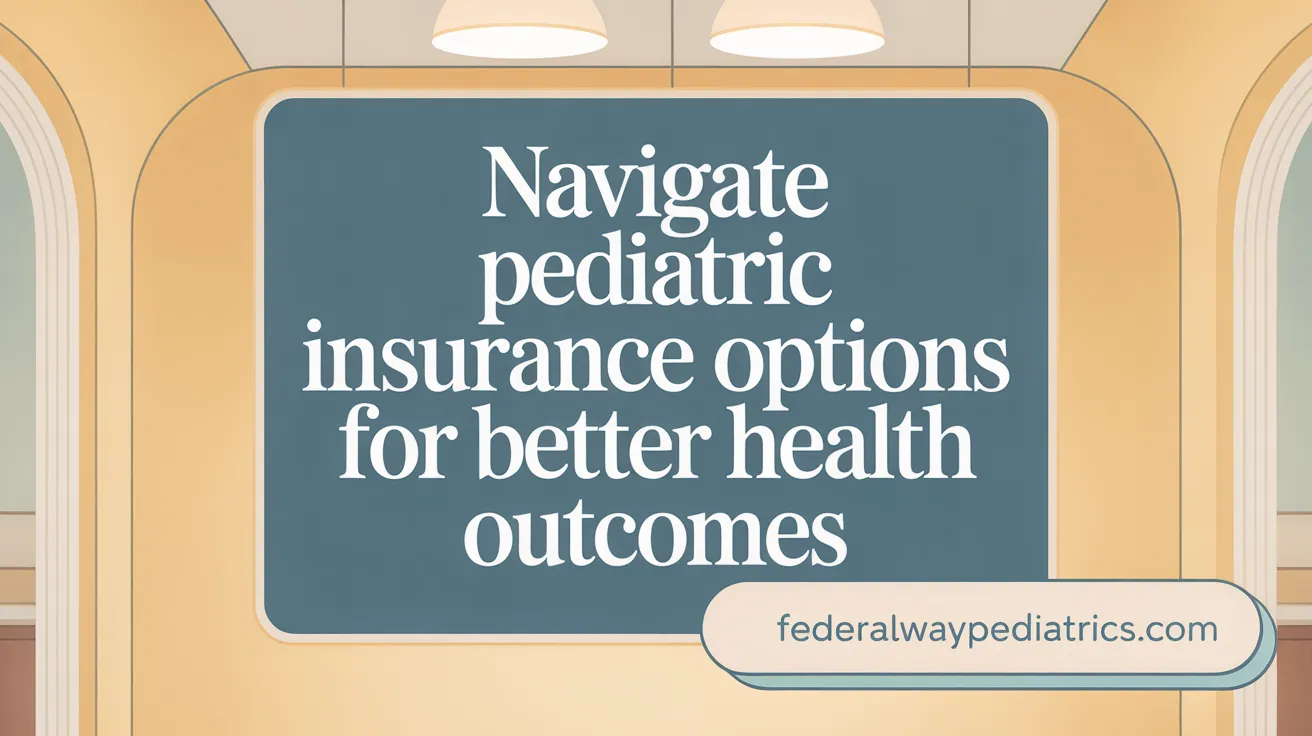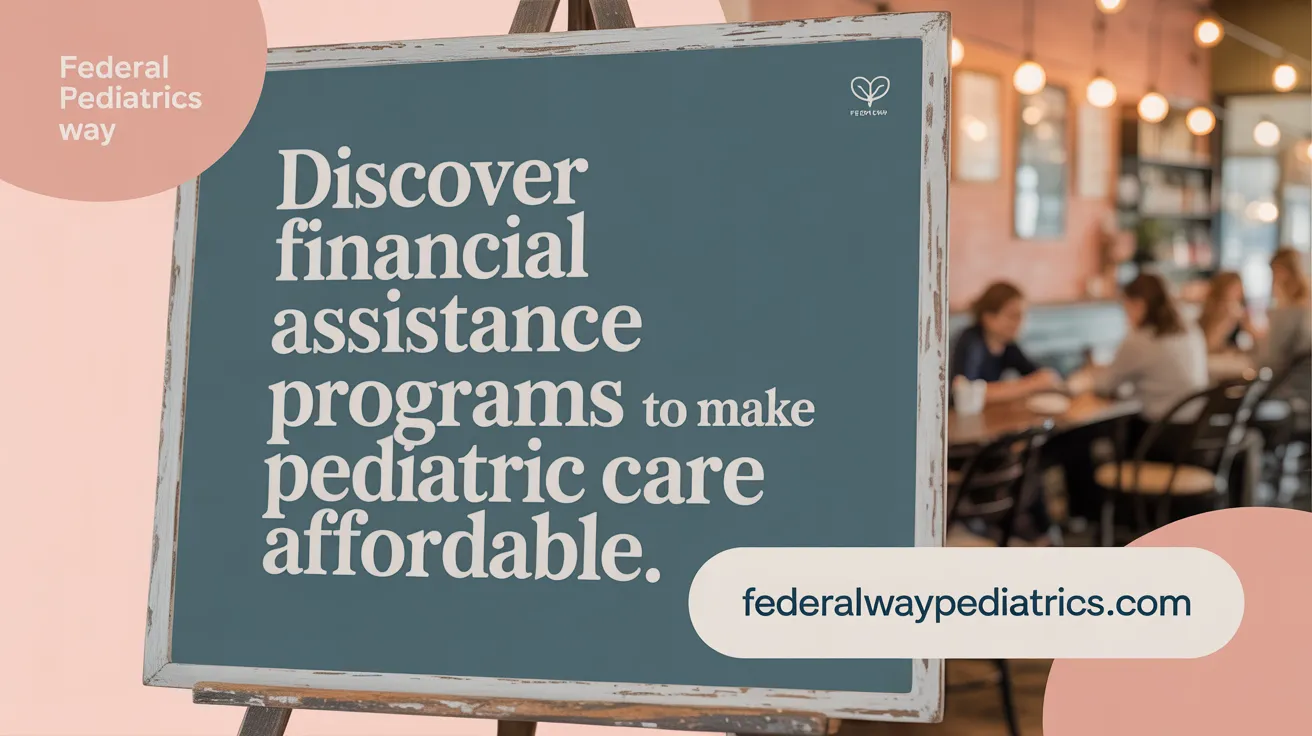Understanding Pediatric Care Financing
Overview of Pediatric Care Financing Options
Families have multiple avenues to finance pediatric healthcare, including employer-sponsored insurance, government programs like Medicaid and CHIP, and private insurance plans. Medicaid and CHIP serve nearly half of U.S. children, offering comprehensive coverage with no waiting periods for medically necessary services. Washington State’s Apple Health for Kids is a key program providing free or low-cost coverage to eligible children, facilitating access to essential health services.
Importance of Insurance for Pediatric Healthcare Access
Insurance coverage is crucial for ensuring children receive timely and comprehensive medical care. Programs like Medicaid and CHIP improve health outcomes by covering preventive screenings, vaccinations, chronic disease management, and specialized care. Continuous eligibility policies, such as those in Washington state for children under six or those with premiums, provide stability and reduce coverage interruptions. Low-income families benefit from income-based premium tiers, making coverage affordable.
Basic Introduction to Pediatric Payment Methods
Pediatric care providers use standardized coding systems—ICD for diagnoses and CPT for procedures—to bill services to insurance plans. Payment models vary from global fees for bundled services to itemized billing for individual procedures like vaccinations and office visits. Families may receive explanations of benefits detailing coverage and out-of-pocket costs such as copayments, deductibles, and coinsurance. Understanding billing and insurance processes helps families anticipate costs and access financial assistance programs when needed.
Overview of Insurance Coverage for Pediatric Care

What are the primary insurance options available for pediatric care?
Primary insurance options for pediatric care include government programs like Medicaid and the Children's Health Insurance Program (CHIP), which together serve about half of all children in the United States. These programs provide comprehensive coverage for low-income families and children with special health care needs, with Medicaid covering all medically necessary services through Early and Periodic Screening, Diagnostic and Treatment (EPSDT). CHIP expands coverage to children in families with incomes too high for Medicaid but still below private insurance affordability. Medicaid and CHIP coverage for children
Medicaid eligibility criteria and benefits vary by state, but generally include no waiting periods and a broad range of covered services. Federal matching funds support these programs, encouraging states to expand pediatric coverage. Proposed policy reforms aim to standardize benefits, ensure continuous eligibility, increase funding, and improve provider payments to reduce disparities. Apple Health Medicaid eligibility for children
Beyond public programs, employer-based health insurance plans and private insurance are widely used. These plans often involve premiums, copayments, and deductibles, and may have limitations or delays in approval for Pediatric home health payment challenges and specialty care. Families are encouraged to verify plan coverage and understand coding and billing processes with their pediatrician's office to manage costs effectively. insurance coverage for children's healthcare Insurance at Seattle Children's
In Washington State, children may qualify for free or low-cost coverage through Apple Health for Kids program, with income limits varying by household size. Children maintain continuous eligibility through early childhood, ensuring stable access to care. Premium tiers help families afford coverage beyond the free eligibility threshold, and enrollment supports access to comprehensive physical and behavioral health services.
| Insurance Type | Coverage Focus | Notes |
|---|---|---|
| Medicaid | Low-income children, EPSDT | No waiting periods, broad service coverage |
| CHIP | Children above Medicaid threshold | Expands access, higher federal match |
| Employer-based Plans | Varying benefits, copayments | May require pre-authorization for specialty care |
| Private Insurance | Wide availability, varied costs | Potential limits on home health and therapies (Pediatric home health payment challenges |
Understanding these options helps families navigate pediatric care and access necessary health services effectively. Paying for your child's home health care
Washington State’s Apple Health for Kids Program
How does Washington State support pediatric insurance coverage?
Washington State supports pediatric insurance needs through the Apple Health for Kids program, which offers free or low-cost health coverage for children up to age 19. Eligibility is based on household income, with thresholds adjusted for household size; for example, a single child qualifies for free coverage if income is at or below $2,804 per month. This program ensures children have vital access to health services by minimizing financial barriers.
Eligibility criteria for Apple Health for Kids
Children who are Washington residents under 19 years of age can qualify if their household income falls within set limits. Children of families with higher incomes may access coverage via premium tiers. Notably, children of public and school employees with insurance under PEBB or SEBB may also be eligible, providing a broad safety net. More details about Apple Health coverage for children are available.
Continuous eligibility policies for children under and over age 6
Children under age 6 who are eligible for free Apple Health maintain continuous eligibility policies in Medicaid and CHIP through the month they turn six, safeguarding uninterrupted care despite income fluctuations. For children aged 6 and above, 12 months of continuous eligibility promotes coverage stability, simplifying renewal and maintaining consistent healthcare access. Information about continuous eligibility for children under Apple Health is provided by Washington State HCA.
Premium tiers and coverage options
The program offers two premium tiers to accommodate families with varying income levels: Tier 1 charges $20 per child per month (max $40 per family) for households with income up to $3,456 monthly, while Tier 2 charges $30 per child per month (max $60 per family) for incomes up to $4,134. These tiers make coverage affordable and flexible. See more on Apple Health for Kids premium levels and coverage options.
Application process and documentation requirements
Families can apply online or through local resources providing assistance. Required documentation includes household income verification, Social Security numbers, birthdates, and immigration status if applicable. After approval, children receive a ProviderOne services card within roughly two weeks, with coverage starting from the first day of the application month. The application process for Apple Health for Kids explains these steps and necessary documents.
Coverage benefits including physical and behavioral health
Apple Health for Kids covers comprehensive physical and behavioral health services. This includes preventive care, immunizations, screenings, and treatment for acute or chronic conditions. Services are available through managed care or fee-for-service options, ensuring children receive holistic and continuous health support. More information about comprehensive pediatric health services covered by Apple Health is available.
Home Health Care Services and Insurance Coverage for Children with Complex Needs

What home health care services are available for pediatric patients?
Advances in medical technology enable infants and children with complex or chronic conditions to receive a broad range of health services at home. These include care plans implementation, medication administration, respiratory support (for children with ventilators or tracheotomy tubes), wound care, mobility assistance, family education, and hospice services. Providers range from registered nurses and therapists (physical, occupational, speech) to social workers, nutritionists, and personal care aides. For detailed information, see home health care for children with complex medical needs.
How does Medicaid support home health care for children?
Medicaid funds over 75% of pediatric home health care, covering nursing services, medical supplies, and various therapies essential for children who transition from intensive care units (NICU or PICU) with life-sustaining equipment. Additionally, programs like Medicaid waivers (e.g., CCP and MDCP) help families keep children with special health needs at home. More information on Medicaid coverage for pediatric home health care and Medicaid waivers supporting home living for children is available.
What challenges affect payment rates and access to home health care?
Despite broad Medicaid coverage, low reimbursement rates often limit provider availability and the scope of services offered. Private insurance plans may impose coverage limitations and delays, further complicating access for families. Ensuring adequate payments is vital to maintain high-quality pediatric home care services. For further insight, review Pediatric home health payment challenges.
What is the pediatrician’s role in managing home health care?
Pediatricians act as medical homes, overseeing care coordination, prescribing treatments, monitoring progress, and advocating for children’s healthcare needs. They serve as the primary point of contact, ensuring that all providers deliver comprehensive and integrated care tailored to each child’s complex medical condition. The role of pediatricians in home health care highlights this crucial function.
| Topic | Details | Importance |
|---|---|---|
| Pediatric home health services | Includes nursing, therapies, respiratory and wound care, family education | Enables children to receive complex care safely at home |
| Medicaid coverage | Covers most services with specialized waivers for children with special needs | Critical funding source for accessible home health care |
| Payment challenges | Low Medicaid rates and insurance limits can restrict access | Affects availability and quality of pediatric home health providers |
| Coordination by pediatricians | Pediatricians manage and coordinate care as the medical home | Ensures continuity and comprehensive support for children with medical complexity |
Billing and Coding Practices in Pediatric Care
How are pediatric care services billed and coded for insurance?
Pediatric healthcare services are systematically billed using standardized coding systems to ensure clarity and consistency in insurance claims. Diagnoses are reported with ICD (International Classification of Diseases) codes, while procedures and treatments employ CPT (Current Procedural Terminology) codes. These codes facilitate communication between the pediatric practice and insurance providers, streamlining the reimbursement process.
Vaccinations in pediatrics present particular coding complexities. Each vaccine involves two CPT codes: one for the vaccine serum itself and a second for its administration. This separation means families might see multiple codes associated with a single vaccination event, which can influence how insurers process and reimburse these services. For more details on vaccination billing codes, refer to pediatric coding information.
Billing models vary across practices. Some utilize a global billing approach where multiple services are bundled into a single code, whereas others bill each service itemized (a la carte), reflecting every specific procedure or test performed. This difference affects how payments are calculated and what out-of-pocket expenses families might expect.
After processing claims, insurance companies provide families with an Explanation of Benefits (EOB). This document details which charges were covered, the amount paid, and any remaining balances or co-payments owed by the patient. Understanding the EOB can help families manage their healthcare finances more effectively.
Parents are encouraged to communicate openly with their pediatric provider’s billing office to clarify any questions about codes, charges, or insurance coverage.
| Aspect | Details | Impact on Families |
|---|---|---|
| ICD and CPT Codes | Standardized diagnosis and procedure codes | Ensures accurate billing and coverage |
| Vaccination Coding | Separate codes for vaccine and administration | Can cause multiple billing entries |
| Billing Models | Global vs. itemized (a la carte) | Influences total billed amounts |
| Explanation of Benefits | Explained insurance coverage and patient dues | Helps families understand payments due |
Financial Assistance and Payment Options at Pediatric Care Facilities

What financial assistance options are available for families receiving pediatric care?
Families accessing pediatric care can benefit from various financial assistance programs designed to reduce the burden of medical expenses. Seattle Children’s in Federal Way and throughout Washington offers a comprehensive Financial Assistance Program that supports families who meet specific income eligibility thresholds. This program provides partial discounts ranging from 55% to 80% of medical bills based on family income relative to Federal Poverty Guidelines, helping those with incomes from 401% to 599% of the poverty level.
Eligibility criteria include not only uninsured families but also insured families, including those covered by Medicaid. This inclusive approach ensures broader access to pediatric care. Additionally, the hospital offers assistance with applications for Medicaid and other state programs such as Washington Apple Health, which can further reduce healthcare costs for eligible children.
For families who encounter short-term financial challenges, interest-free payment plans are available to spread out medical costs without additional financial strain. These plans make critical pediatric care more affordable and manageable.
Seattle Children's applies policies such as the Amounts Generally Billed (AGB) to limit charges for eligible patients receiving emergency or medically necessary services. While some services like cosmetic procedures are excluded, this policy reflects the commitment to fair billing practices for families in need.
In summary, financial assistance at pediatric facilities like Seattle Children’s includes income-based discounts, help with Medicaid and state health program enrollment, and flexible payment arrangements—all designed to support families in Federal Way and surrounding areas as they navigate the costs of pediatric care.
Insurance Verification and Patient Responsibilities in Federal Way Pediatric Clinics

What should families know about insurance verification and payments at pediatric clinics?
Families seeking pediatric care in Federal Way are strongly encouraged to verify their insurance coverage prior to clinic visits. This crucial step helps ensure that visits remain affordable and that there are no unexpected out-of-pocket expenses. For more information about Billing and Payments, accepted Insurance Plans, and managing Insurance Verification and Online Payment Options, families can consult clinic-specific resources.
Patients are typically responsible for common costs such as copayments, deductibles, and coinsurance. These charges must be paid at the time of service, and most clinics accept a variety of payment methods such as cash, major credit cards, and checks. Details about Payment Options and Schedules can assist families in planning ahead.
To simplify payments, many pediatric clinics provide online patient portals where payments can be securely made anytime. This option is convenient for families managing busy schedules and is supported by many practices, including guidance on pediatric insurance claims, Explanation of Benefits, and billing challenges.
In cases of claim rejections or unexpected high balances, clinics often offer guidance and support. Staff can assist families in understanding insurance denials and navigating billing inquiries to help manage financial expectations and explore payment assistance options when needed, as outlined in Seattle Children's Financial Assistance Program.
Specialized Pediatric Cardiology Coverage and Services

How is insurance managed for specialized pediatric cardiology care?
Pediatric cardiology care in Federal Way involves coordination with families' insurance plans to ensure coverage and smooth access to services. Many insurance providers do not require pre-authorization for specialty cardiology consults at clinics like Seattle Children’s South Sound Cardiology, which reduces delays in care. However, certain plans, such as Kaiser Health Foundation Plan of Washington and TriCare, do require pre-authorization before scheduling. It is important for families to verify their specific insurance plan requirements early. For more on insurance coverage and payment policies, see Insurance at Seattle Children's.
Services offered at pediatric cardiology clinics
The South Sound Cardiology clinic offers comprehensive services for infants, children, and teens with heart conditions. Care includes prenatal consultation for expectant parents, echocardiograms (including fetal echocardiograms), electrocardiograms (EKGs), management of heart rhythm disturbances, and ongoing care from infancy through young adulthood. Support teams consist of pediatric cardiologists, nurses, sonographers, and family service coordinators to provide holistic specialist care. Learn more about the full range of specialized cardiology services at South Sound Cardiology Clinics.
Coordination with insurance and pre-authorization requirements
Families should be aware that while many insurance plans cover cardiology services without pre-authorization, some do require prior approval. Pediatric cardiology providers assist in navigating these processes to prevent interruptions in care. Understanding plan specifics and maintaining communication with the clinic's billing office can help families manage expectations and out-of-pocket costs. For information on billing and insurance plans, refer to Insurance Plans Accepted at Seattle Children's and Billing and Payments for Pediatric Care.
Accreditation and the importance of accessing quality specialty care
Clinic accreditation by the Intersocietal Accreditation Commission (IAC) for transthoracic and fetal echocardiography signifies adherence to high standards of diagnostic quality and safety. Accessing accredited specialty clinics is crucial for accurate diagnosis and effective treatment of pediatric heart conditions, offering families confidence in the care provided. More detailed information on cardiology accreditations can be found at South Sound Cardiology Clinic.
Understanding Medicaid and CHIP’s Impact on Pediatric Care
What impact do Medicaid and CHIP have on pediatric healthcare?
Medicaid and the Children’s Health Insurance Program (CHIP) play a crucial role in the healthcare of approximately half of all children in the United States. These programs ensure timely access to essential and medically necessary pediatric services, supported through the Early and Periodic Screening, Diagnostic and Treatment (EPSDT) benefit. The Affordable Care Act expanded Medicaid eligibility to cover children in households with incomes up to 138% of the federal poverty level, significantly broadening coverage for vulnerable families. For more detailed insights, see Medicaid and CHIP coverage for children.
How have Medicaid and CHIP improved pediatric health outcomes?
By offering comprehensive coverage without waiting periods and including a range of physical and behavioral health services, Medicaid and CHIP have contributed to reductions in neonatal and childhood mortality rates. They also promote positive lifelong outcomes, such as improved educational attainment and greater economic stability. These programs are instrumental in reducing disparities in healthcare access for children from low-income and marginalized communities. Learn more about Washington Apple Health for Kids and coverage.
What are the federal and state distinctions in Medicaid and CHIP?
While Medicaid and CHIP receive federal funding with matching rates ranging from 50% to 77%, states administer the programs with significant discretion over eligibility, covered benefits, and payments. This structure results in variability in access and services across states. CHIP supplements Medicaid by covering children whose family incomes exceed Medicaid thresholds but still find private insurance unaffordable, offering another critical safety net. Additional info is available at Medicaid and the Children’s Health Insurance.
What reforms are proposed to improve pediatric healthcare access and equity?
Current efforts include proposals for universal eligibility for children up to age 26, automatic enrollment at birth, and standardization of benefits to minimize disparities among states. Increasing federal oversight and funding aims to strengthen provider reimbursement and expand coverage for mental health and social support services. These reforms seek to create equitable and comprehensive pediatric healthcare access nationwide. For policy recommendations and regulatory information, refer to AAP recommendations for pediatric home health regulations.
Empowering Families: Navigating Pediatric Insurance and Payments with Confidence
Understanding Pediatric Insurance and Payment Options
Families seeking pediatric care for their children in Federal Way and beyond have access to multiple insurance programs. Apple Health for Kids offers free or low-cost plans based on household income, with continuous eligibility provisions ensuring stable coverage for children under and over six years old. Medicaid, including Washington's Apple Health, plays a vital role in covering essential health services such as immunizations, therapies, and hospital care.
The Role of Billing and Coverage Awareness
Healthcare billing uses specific coding systems like ICD and CPT to ensure accurate claims processing. Pediatric visits often involve multiple codes corresponding to various services, making it important for families to understand how their benefits work, especially regarding copayments, deductibles, and coverage limits. Pre-authorization requirements may vary depending on the insurance plan used.
Financial Support and Resources
In addition to insurance options, programs like Seattle Children's Financial Assistance help families manage costs, including income-based discounts and payment plans. Families are encouraged to consult pediatricians and insurance representatives to clarify coverage details, understand billing statements, and explore all available assistance.
By proactively engaging with these resources and understanding insurance processes, families can better manage pediatric healthcare expenses, ensuring their children receive comprehensive, compassionate care without undue financial stress.
